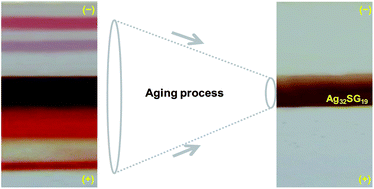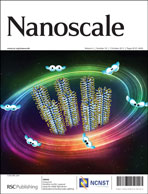Thiolate-protected Ag32 clusters: mass spectral studies of composition and insights into the Ag–thiolate structure from NMR†
Abstract
Clusters composed of a 32 silver atom core, protected with thiolates of glutathione (GSH) and N-(2-mercaptopropionyl)glycine (MPGH), were synthesized by a solid-state route in milligram scale. They do not exhibit surface plasmon resonance unlike their larger sized nanoparticle analogues but show molecule-like features in absorption and luminescence spectra, falling in the visible window. The compositions Ag32SG19 (SG: thiolate of glutathione) and Ag32MPG19 (MPG: thiolate of MPGH) were identified from electrospray ionization mass spectrometry (ESI MS). Matrix-assisted laser desorption/ionization mass spectrometry (MALDI MS) was not successful for –SG protected clusters as reported before, but for Ag32MPG19 a peak at 6.1 kDa was seen at a threshold laser intensity. This peak shifted to low mass region with increasing laser intensity due to systematic losses of Ag2S. Further confirmation of the composition Ag32SG19 was made using various studies such as XPS and EDAX. One-dimensional (1D) and two-dimensional (2D) NMR spectroscopic investigations of Ag32SG19 provided interesting spectral features which indicated the dominant –[SR–Ag–SR]– structural motif. This structural motif as the predominant entity is found for the first time in silver clusters.


 Please wait while we load your content...
Please wait while we load your content...